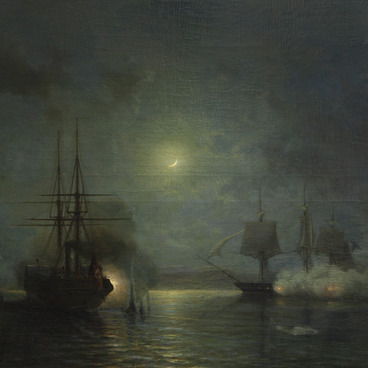Saint Michael is revered in Orthodox tradition as the Archangel — the leader of the heavenly hosts — who was appointed by God above all the other angels and archangels. Both the Old and the New Testament mention his name. According to the Bible, Saint Michael defeated Lucifer, a fallen angel who rebelled against God out of pride and became Satan, and threw him out of heaven. Some Christians believe that it was Michael the Archangel who was chosen by God to guard the gates to Paradise after the expulsion of Adam and Eve from the Garden of Eden. According to Biblical apocrypha, the Lord entrusted Saint Michael the Archangel with the souls of the righteous, therefore he is revered for his power to intercede on behalf of the dead at the Last Judgment.
The most famous mention of the Archangel is in the Revelation of St. John the Theologian. The complex symbolism and allegory of the icon from the museum’s collection is based on the Revelation text, without, however, becoming a direct illustration of any particular verse. The crowned Angel, whose face is as bright as fire, holds a trumpet to his mouth. He wears knightly armor and rides a winged red horse. The red color indicates that Saint Michael belongs to the Kingdom of Heaven. In one hand, the Archangel holds a cross and a spear, which he points at Satan’s mouth; in the other hand, he has the Gospel and a thurible. The rainbow above his head symbolizes the Lord’s mercy and the fulfillment of His covenant — the cessation of God’s anger, the earth’s destruction in fire and its subsequent renewal. The cross, the trumpet, the thurible and the book are the objects foreshadowing the Apocalypse. According to the Revelation, when the seals on the Book of Life were opened, there appeared seven angels with trumpets and an angel with a golden censer. The crown on Michael’s head signifies that he is the most powerful angel, the prince, the leader of the army of the Lord.
In the top left corner, Christ Emmanuel is depicted behind the throne called ‘Hetoimasia’. On the right are the angels who crush demons with their spears. Below the rider, Satan is painted with a face on his belly and the city drowning in the lake of fire. The icon features some inscriptions which help understand the imagery of the plot.
The icon ‘Saint Michael the Archangel — the leader of the heavenly hosts’ from the museum collection is the earliest dated image of this type in the region around Lake Baikal. In the 18th –19th centuries, the iconography of the Archangel on horseback holding the symbols of the Apocalypse became immensely popular among common icon painters. The demand for this iconographic type turned out to be especially high among the Old Believers, a group of religious dissenters who refused to accept the liturgical reforms in the mid-17th century.
SBIC ‘The Irkutsk Regional Art Museum named after V. P. Sukachev’
The most famous mention of the Archangel is in the Revelation of St. John the Theologian. The complex symbolism and allegory of the icon from the museum’s collection is based on the Revelation text, without, however, becoming a direct illustration of any particular verse. The crowned Angel, whose face is as bright as fire, holds a trumpet to his mouth. He wears knightly armor and rides a winged red horse. The red color indicates that Saint Michael belongs to the Kingdom of Heaven. In one hand, the Archangel holds a cross and a spear, which he points at Satan’s mouth; in the other hand, he has the Gospel and a thurible. The rainbow above his head symbolizes the Lord’s mercy and the fulfillment of His covenant — the cessation of God’s anger, the earth’s destruction in fire and its subsequent renewal. The cross, the trumpet, the thurible and the book are the objects foreshadowing the Apocalypse. According to the Revelation, when the seals on the Book of Life were opened, there appeared seven angels with trumpets and an angel with a golden censer. The crown on Michael’s head signifies that he is the most powerful angel, the prince, the leader of the army of the Lord.
In the top left corner, Christ Emmanuel is depicted behind the throne called ‘Hetoimasia’. On the right are the angels who crush demons with their spears. Below the rider, Satan is painted with a face on his belly and the city drowning in the lake of fire. The icon features some inscriptions which help understand the imagery of the plot.
The icon ‘Saint Michael the Archangel — the leader of the heavenly hosts’ from the museum collection is the earliest dated image of this type in the region around Lake Baikal. In the 18th –19th centuries, the iconography of the Archangel on horseback holding the symbols of the Apocalypse became immensely popular among common icon painters. The demand for this iconographic type turned out to be especially high among the Old Believers, a group of religious dissenters who refused to accept the liturgical reforms in the mid-17th century.
SBIC ‘The Irkutsk Regional Art Museum named after V. P. Sukachev’


